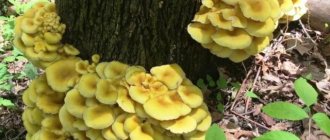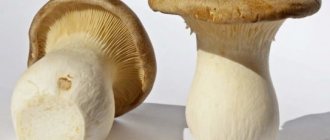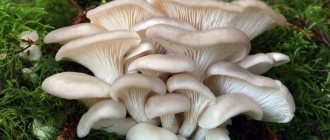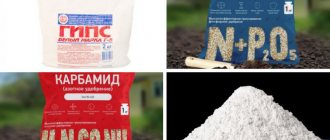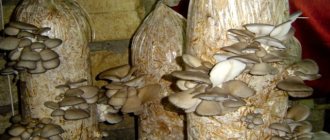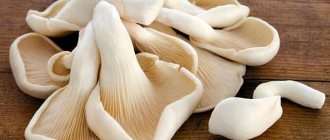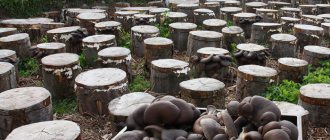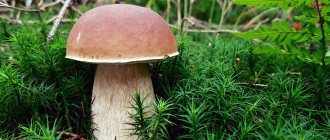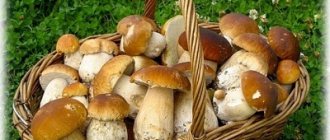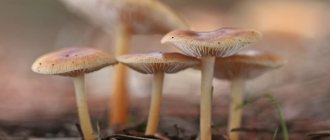Short description
| Type of mushrooms: | Conditionally edible |
| Other names (synonyms): | Late panellus, Late oyster mushroom, Alder oyster mushroom |
| Latin name: | Panellus serotinus |
| Family: | Mycenaceae |
| Distinctive feature: | Autumn oyster mushroom is a harbinger of the end of the mushroom season; it begins to bear fruit in late autumn or winter, depending on the region. |
| Beginning of the season: | September |
| End of season: | December |
| Leg height (cm): | 0.8-1.5 cm |
| Cap width (cm): | 3-10 cm |
| Smell: | absent |
| Taste: | bland or bitter |
| Tasting score: | – |
| Hat: | semicircular, convex in youth, wavy at the edges, smooth, when wet it is very sticky, then becomes sharp and sometimes striped. Light green, yellow, olive, brown or reddish olive. |
| Leg: | short, with small dots of dark ocher-colored scales on a saffron-yellow background, sometimes completely absent. |
| Hymenophore (bottom of cap): | the plates are first creamy, and then creamy-ocher, wide at the edge, towards the stem, which become narrow, forked, the edges are smooth. |
| Disputes: | cylindrical, allantoic, 4-6.6 x 1.2-1.5 µm. |
| Pulp: | watery, whitish, thick around the stem. With age it becomes rubbery and tough. |
| Natural environment and mycorrhiza: | on the wood of various deciduous trees, sometimes on conifers. |
| False doubles: | differs from similar mushrooms in the non-leathery fleshy cap. |
| Growing: | This mushroom is grown on an industrial scale in Germany, Japan, Holland and France. |
| Use: | conditionally edible. Can be eaten after preliminary boiling for 15 minutes or more. |
| Medicinal properties: | – |
| Spreading: | widespread in Europe and North America. |
Lovers of quiet hunting, true connoisseurs of mushrooms, highly value oyster mushrooms not only for their taste. It is never affected by worms and grows at a time when there are practically no other mushrooms. Found in the forest in fairly large groups.
Preparation
Late forest oyster mushrooms often have a bitter taste.
It appears when mushrooms age, as well as when they grow in a certain environment. Therefore, it is recommended to collect only young fruits. Oyster mushrooms are “clean” mushrooms; they practically do not need cleaning; you may only need to remove particles of soil near the cut
You need to handle pigs very carefully, as they are fragile and crumble and should not be dropped. The prepared fruits are washed in plenty of water and soaked in a weak salt solution for half an hour.
This relieves them of bitterness. Next, you can begin heat treatment. Oyster mushrooms are used to prepare:
- soups;
- second courses;
- casseroles;
- salads;
- pickles.
The taste of these mushrooms goes well with meat, various vegetables and cereals.
Fried oyster mushrooms are very tasty. There is a widespread belief that this is a dangerous mushroom that must be boiled before frying, but this is not true. Oyster mushrooms can be fried immediately after harvesting; they do not require repeated heat treatment.
Oyster mushrooms fried with onions
This is a simple dish, but if you know some cooking secrets, it will turn out especially tasty and aromatic.
Ingredients:
- oyster mushrooms – 600 g;
- onion – 250 g;
- Sunflower oil – 50 g;
- garlic – 3 cloves;
- dill - several sprigs;
- green onion - a few feathers;
- salt.
Preparation:
- Cut the washed oyster mushrooms into small cubes.
- Peel and chop the onion in the same way.
- Heat a frying pan with a thick bottom and pour oil into it.
- When the oil is hot, add the onion and fry until golden brown.
- Add mushrooms and fry for 15 minutes, stirring.
- Add salt.
- Peel the garlic and chop finely.
- Chop green onions and dill.
- Remove the finished mushrooms from the heat and immediately season with chopped garlic.
- When serving, sprinkle with herbs.
Types of Edible Mushrooms
In the Moscow region you can find almost any type of mushroom
Edible mushrooms in the Moscow region are represented by the following types:
- Porcini mushrooms or boletus mushrooms: they belong to category 1 of nutritional value and are considered the most delicious. They have a brown cap with a wrinkled surface and a stalk with a mesh pattern, thick at the base. Their flesh is white and dense; when cut (and when dried and other types of processing), the color does not change. They grow singly or in small groups in coniferous forests.
- Saffron milk caps: no less valuable mushrooms, which owe their name to the color of their thick, fleshy cap. The stem is long, hollow, and coated. They grow near spruce and pine trees, forming mycorrhiza with them.
- Milk mushrooms (white and yellow): mushrooms belonging to the genus Milk. The white cap has a light cream color with a curved, slightly drooping edge; the yellow one has a corresponding shade; sometimes the cap has a scaly surface. The legs are the same color, hollow inside, the flesh is white, with a fruity smell. Grows mainly in deciduous forests. Used for pickling and salting.
- Butterflies: in the Moscow region they are found in 3 types: ordinary, larch and yellow-brown. They have caps that are brown in color, convex or flat in shape, with a sticky coating on top, as well as thick and fleshy legs. They grow on sandy soil in mixed forests.
- Boletus trees: they got their name because they almost always grow next to birch trees and form mycorrhiza with them. The hat is pillow-shaped, gray-brown in color. The leg is thick and scaly underneath. The pulp remains white even when damaged. Suitable for many dishes.
- Boletuses: grow in deciduous forests, mainly near aspens, for which they are symbionts. They have a convex, brownish-brown cap and a thick, scaly gray stem. The pulp is dense and gradually turns black when cut.
- Volnushki: mushrooms of the 2nd flavor category. Their hat is light with a pinkish tint and stripes, the edges are lowered. The leg is hard, cylindrical. The pulp is dense and has a pungent taste. Be sure to soak before use.
- Honey mushrooms (autumn and summer): grow in large groups, have a small convex cap of a light brown color and a thin scaly stem. They are pickled, salted, dried, and made into soups.
- Chanterelles: small mushrooms with a funnel-shaped cap, a pleasant yellowish-orange color. The flesh is fleshy, turning red when cut. They prefer coniferous trees. Suitable for food in any form. They are practically not affected by parasites due to the presence of a special compound - quinomannose.
- Moss mushrooms: category 3 mushrooms. In the Moscow region, the most common types of these mushrooms are green flywheel and fissured flywheel. They have a convex cap of an olive shade; the cracked one has a mesh pattern on top. The leg of the green moss is thickened at the top, while that of the fissured moss is thick at the bottom. The pulp is white, turning blue when broken. This type is dried and salted.
- Russula: representatives of lamellar mushrooms, owners of large and fleshy fruiting bodies. The colors of the caps of edible species are bright green, pink, ocher, blue and yellow. For preparation in salted and pickled form, only young fruiting bodies are used.
- Morels: early spring mushrooms of category 3. They have a wrinkled, honeycomb-like cap that is brown or gray in color. It is boiled and added to side dishes.
- Puffballs: small mushrooms whose fruiting bodies are white when young and have small formations resembling spines. They love moist soil and bear fruit abundantly after prolonged rains. Only young specimens are used for food fried.
Edible mushrooms in the Moscow region have their inedible and poisonous counterparts. Knowing the description of poisonous mushrooms found in the Moscow region, it will not be difficult for an amateur mushroom picker to avoid poisoning.
Panellus astringent: photo and description
| Name: | Panellus astringentus |
| Latin name: | Panellus stipticus |
| View: | Inedible |
| Characteristics: |
|
| Taxonomy: |
|
Panellus astringentus - it may immediately seem like an unremarkable mushroom, if you do not know about its interesting characteristic - the ability to glow in the dark. Many mushroom pickers have repeatedly seen entire colonies of panellus clinging to rotten stumps or fallen trees, but did not think about what metamorphoses occur with the coming of night.
Sarcoscipha scarlet mushroom: what is hidden under this mysterious name?
Many mushrooms remain mysterious organisms that scientists never cease to study, and culinary specialists continue to discover all sorts of flavors and create new dishes using forest gifts. Sarcoscipha scarlet is a unique and interesting species of marsupial mushrooms, overgrown with secrets and legends.
Description
The mushroom belongs to the genus Sarcoscypha, a family of the same name, and is a species of marsupial. Despite its rarity and uniqueness, this species is not included in the Red Book. It is widespread throughout the world: in Asia, Africa, Europe, America, Australia.
Sarcoscipha has a number of other names. Latin Sarcoscypha coccinea and Sarcoscypha austriaca, it is also often called bright red Sarcoscypha or cinnabar red. The names Sarkoscyfa Austrian, Petsitsa red and Scarlet Elf's Cup are found.
If we describe the appearance of the mushroom, then it is a saprophyte that grows on the trunks or branches of trees; it has a fairly small size, elastic flesh, and a low stalk.
The edges of the cap are turned inward and are pale pink or white.
A hymenophore is a part of the fruiting body of a fungus that bears a thin spore-bearing layer on the surface. In Sarcoscypha it has a pale pink or white color and a frequent structure without divisions into stripes. The pulp is elastic, with a pleasant mushroom aroma.
A little history
It is the type species of the genus Sarcoscipha. Scientists from Europe (presumably Austria) described it in 1772, although it had been known for a long time. The mushroom was first used as food long before its official discovery. It was known to ancient hunters and gatherers.
Time and place of fruiting in Russia and the world
The time of appearance of this mushroom is late winter or early spring. But already in May the fruiting process ends. The first fruiting bodies begin to be collected at the end of winter.
They grow in ecologically clean places in areas with a temperate climate. Found in the forests of Eurasia, Africa, and America. It’s not easy to find them - mushrooms choose dead wood, branches and fallen leaves.
Sometimes seen on the remains of trees and moss. They grow in groups, and in the warm fall a second crop of mushrooms may appear in some areas.
Sarcoscipha is also found in the forests of Russia and is common in its European part; there are especially many such mushrooms in Karelia.
False doubles
The mushroom has very similar brothers, some of which are poisonous.
| Aleuria orange | Sarcoscypha occidentalis | Hot and caustic russula |
| edible | edible | inedible |
| spherical shape | saucer shape | saucer shape |
| color orange, reddish | the color is reddish, brighter than the original | ocher color |
| The leg is shorter | The leg is longer | The leg is longer |
| Non-poisonous | Non-poisonous | Poisonous |
| The area coincides | Grows only in the USA | Grows in Western Europe |
IMPORTANT: the pungent russula is the most dangerous species presented. It differs in that it has an ocher color, but the cap is often similar in appearance to Sarcoscipha - also reddish
However, the mushroom itself is dangerous to health. Even after trying it, a person experiences a strong burning sensation on the tongue. By the way, the older the mushroom, the brighter its cap. When consumed, it can cause symptoms similar to ordinary poisoning, but in children it can cause serious health problems.
The difference can be seen in the photo.
Evaluation of taste qualities and medicinal properties
Sarcoscifa does not have a very attractive taste (if not prepared correctly). But if you properly boil or marinate it, the mushroom becomes tender and tasty. The main thing is to let it freeze properly, and before that, wash and clean it.
This mushroom is used in the manufacture of various medicines, as well as for the treatment of diseases of the gastrointestinal tract. It is also prescribed as part of a diet for weight loss.
Panellus stipticus
Panellus stipticus is a bioluminescent mushroom, a fairly common species of mushroom with a wide habitat.
External description
The fruiting body of the panellus astringentus consists of a cap and a stalk. The mushroom is characterized by leathery and thin flesh that is light or ocher in color. It has an astringent taste, a little acrid.
The diameter of the mushroom cap is 2-3 (4) cm. Initially, its shape is kidney-shaped, but gradually, as the fruiting bodies mature, the cap becomes depressed, ear-shaped, fan-shaped, covered with grains and many small cracks. The surface of the cap is matte, and its edges are ribbed, wavy or lobed. The color of the cap of this mushroom can be pale ocher, light brown, ocher-brown or clayey.
The hymenophore of the astringent panellus is represented by plates that are characterized by a small thickness, grow to the surface of the fruiting body, are very narrow and located at a short distance, reach almost down the stem of the mushroom, and have bridges that are the same color as the cap (sometimes a little darker than it). The color of the plates is often gray-ocher or light brown. Their edges are slightly lighter than the middle.
Season and habitat of the mushroom
You can meet panellus astringent in a fairly large area. It grows in Asia, Europe, Australia, and North America. The described type of mushroom is found in the northern part of Russia, Siberia, the Caucasus, and the Primorsky Territory. But in the Leningrad region this mushroom is practically never found.
Panellus astringentus grows mainly in groups, on rotting stumps, logs, and trunks of deciduous trees. It grows especially often on beeches, oaks and birches. The size of the described mushroom is very small and often these mushrooms completely cling to entire stumps.
Active fruiting of astringent panellus begins in the first half of August. Some literary sources also write that the fruiting bodies of the described mushroom begin to actively grow in the spring. Until late autumn, entire colonies of astringent panellus appear on dead wood of deciduous trees and old stumps, which often grow together at the base. You don’t see them too often, and the drying of mushrooms of the described species occurs without the involvement of rotting processes. In spring, you can often see dried fruiting bodies of astringent panellus on stumps and old tree trunks.
Similar types and differences from them
Panellus astringentus is somewhat similar in appearance to an inedible mushroom called panellus musculosum (tender). True, the latter is distinguished by white or whitish fruiting bodies. These mushrooms have a very mild taste, and they grow mainly on fallen branches of coniferous trees (usually spruce).
Other information about the mushroom
The bioluminescent properties of panellus astringent arise from a chemical reaction involving luciferin (a light-emitting pigment) and oxygen. The interaction of these substances leads to the fact that the tissues of the fungus begin to glow greenish in the dark.
Characteristics of liver mushrooms
The liverwort is the only representative of the genus Fistulina. By general characteristics, it resembles a fruit from the Tinder family, for which the mother-in-law’s tongue is a distant “relative”.
Appearance and photo
The common liverwort lives on tree trunks and leads a parasitic lifestyle, drawing juices from the wood. In its shape, it resembles a cattle hoof, which often scares away mushroom pickers.
Externally, the mushroom is very similar to raw animal liver, and in the cut areas it even begins to “bleed”, which is clearly visible in the photo.
Structure and species differences
The size of the fruiting body varies between 10-30 cm, and its thickness can reach no more than 6 cm. The mushroom is fleshy and dense, it can be sessile or with a thick small stalk that forms on the side. Sometimes the stem may be buried in the soil, but generally it is attached to the trunk.
The young fruit has a tuberous shape about 5 cm, which resembles an ox tongue. As the mushroom grows, it takes on a wider shape with pointed edges. The surface is wet and brown or red. The rough skin of more mature specimens becomes gelatinous.
The pulp of the fruiting body is quite dense, fleshy and juicy. It has a dark red tint, on which you can see light veins. The radially fibrous flesh resembles liver or raw meat. The smell of the fruit is weak, with fruity notes. The taste of the pulp is sour, sometimes a bitter taste appears.
The hymenophore of this species has an unusual structure. It consists of small individual tubes that can be easily separated. In young fruits, the tubes are difficult to see, and with age the thickness of the layer reaches 1-1.5 cm. The surface is porous and moist. Often, droplets of liquid with a reddish tint can be seen on a straw-yellow or pink surface. When pressed, the color changes to brown-red.
The color of the spore powder is pink, red-brown and white. The spores are round in shape and reach 4.5×5 µm.
Ecological characteristics and distribution location
The liverwort fungus is a parasite and destroyer of trees, because its appearance provokes the development of brown rot of the tree core. The fruit parasitizes on old trees, among which chestnuts and oaks are most often found. It can grow on other deciduous trees and even stumps. The fruiting body is annual and is formed near the root system or on the lower part of the tree. Mushrooms can grow either singly or in small groups.
Mushroom growth sites
Liverworts grow in warm weather after good rain. This is not a very common species, so it is rarely found. You can go hunting from the end of July until the first frost. You should look for the mushroom in oak or mixed forests.
Eating
Liverwort belongs to the fourth food category. It is recommended to collect only young specimens, because old fruits are tough and bitter in taste.
Tip! To remove bitterness, you should soak the crop in cold water for about a day.
Collection rules and conditions
The mushroom begins to bear fruit in mid-summer. In warm regions you can find this species even in November, but it mainly grows until October. It grows unsteadily and there are often lean years. Liverwort settles on weakened and old deciduous trees.
It loves a temperate warm climate, so you should look for it in those regions where winters are short and fairly warm. In European countries, Belarus and some regions of Russia, this species is listed in the local Red Books, because it is considered quite rare.
Unlike most representatives of the mushroom world, the liverwort mushroom does not have false and poisonous counterparts, so even inexperienced mushroom pickers can collect it. Among the forest inhabitants there is not a single one similar to the liver, except for the mother-in-law's tongue.
Panellus astringent: photo and description
| Name: | Panellus astringentus |
| Latin name: | Panellus stipticus |
| Type: | Inedible |
| Characteristics: |
|
| Taxonomy: |
|
Panellus astringentus is an unremarkable mushroom at first glance, if you don’t know about its interesting feature - the ability to glow in the dark. Many mushroom pickers have more than once seen entire colonies of panellus clinging to rotten stumps or fallen trees, but had no idea what metamorphoses occur with the onset of night.
What does panellus astringent look like?
Panellus stipticus is a lamellar mushroom of the Mycenoceae family. The fruiting body consists of a low stalk and a fan-shaped cap.
At a young age, the cap is kidney-shaped, but as it develops it acquires a depressed shape with tucked lobed or wavy edges, reminiscent of an auricle. In a humid environment, the color of the cap is yellow-brown or clayey; when dry, it becomes light ocher. In rare cases, panellus astringent may have an almost white tint. The diameter of the cap does not exceed 2-4 cm, its surface is matte, strewn with grains and covered with small cracks.
The reverse side of the cap is represented by narrow thin plates located close to each other, sometimes branching or soldered in some places by bridges. Their color is identical to the cap, closer to the place of growth the shade is more saturated. The spore powder is white, the spores themselves are oblong and bean-shaped.
The leg is located on the side. Poorly developed. Height – from 1 to 10 mm, with a diameter of 2-7 mm. The shape of the leg is cylindrical, often tapering at the base, without cavities inside. The upper part has pubescence. The color matches the hat or is a little lighter.
The flesh of the panellus astringent is colored cream or ocher. The structure is leathery, elastic. The mushroom has a distinct odor. The taste of the pulp is astringent, slightly acrid and bitter.
Why does panellus astringent glow in the dark?
Panellus astringent is one of the few living organisms capable of bioluminescence. Other representatives of the fungal kingdom glow due to bacteria that have settled on their surface. But panellus astringent emits light due to its own enzyme - luciferase. When interacting with oxygen, the luciferin pigment oxidizes and begins to glow with a cool green glow. Mature specimens glow most brightly during the period of spore maturation. The intensity is enough to avoid using a long shutter speed when photographing.
Where and how does it grow
Mushrooms of the type Panellus astringentus are common in North America and Eurasia. Australia. On the territory of the Russian Federation it can be found throughout almost the entire forest zone. This luminiferous mushroom is not uncommon in regions such as:
Panellus astringent prefers to settle on rotten wood, most often on stumps and fallen trunks of deciduous trees. Especially loves oak, beech, and birch. It grows in numerous groups, sometimes completely clinging to stumps. The main fruiting period is from the first half of August until late autumn; in some places the species can be found in the spring. The fruiting bodies do not rot, but simply dry out. You can often observe entire colonies of last year’s mushrooms fused at the base.
Is the mushroom edible or not?
This representative belongs to the category of inedible mushrooms. Forest fruits are not used for food in any form. Some sources contain information about edibility after heat treatment, however, it is better to refrain from consuming them and not risk your health.
Doubles and their differences
Panellus astringent can be confused with panellus soft (Panellus mitis). The species is distinguished by a lighter, almost white color; young mushrooms have a sticky cap. The inedible twin settles on fallen branches of coniferous trees, most often on fir trees.
The conditionally edible autumn oyster mushroom (Panellus serotinus) is very similar to the astringent panellus. It is distinguished by a gray-brown or green-brown cap, which is covered with a thin layer of mucus.
Conclusion
Panellus astringent is an interesting mushroom to observe and study. It’s rare that anyone gets to see it in all its glory, since you can only find yourself in the forest at night by accident. Looking at the greenish mushrooms shining in the dark, you can once again see how diverse and amazing nature is.
Description
Autumn oyster mushroom is a mushroom of the Mycenaceae family, lamellar, conditionally edible. It has other names - late panellus, late oyster mushroom, alder oyster mushroom, willow oyster mushroom.
hat
The mushroom cap is ear-shaped or lobe-shaped, fleshy. Size from 3 to 8 cm, sometimes up to 15 cm. The structure of the cap is solid. The surface is smooth, in young specimens it is slimy, shiny, then becomes matte, slightly velvety. The edges of the cap are curved at an early age; in old mushrooms they are straight, uneven and thin.
The color is dark, gray-brown with yellow and olive-green hues, being darker at the edges and brownish-yellow in the middle. Occasionally the entire cap is purple. After frost, the color may appear reddish.
Under the cap, the oyster mushroom has plates - frequent, with uneven edges, attached to the stem, sometimes descending. The color of these parts is light, from white to gray-yellow, in young ones - orange. Over time it becomes paler. White spore powder.
Pulp
The pulp of the autumn oyster mushroom can be dense or loose, and watery in rainy weather. As it matures it becomes tougher. Color – white or cream. The smell is weak, sometimes absent. The taste is pleasant, occasionally bitter.
Leg
The mushroom has a short (2-3 cm), curved lateral stalk of a cylindrical shape. Sometimes it can be practically absent. It is covered with small scales, pubescent, and dense in structure.
Taxonomy
The scientific name of the genus is derived from the name of another genus - Panus Fr. (Panus), from which this genus was isolated.
Synonyms
- Dictyopanus Pat. 1900
- Pleurotus sect. Scytinotus (P.Karst.) Pilát, 1935
- Sarcomyxa P.Karst., 1891
- Scytinotus P.Karst., 1879
- Urosporellina E.Horak, 1968
Kinds
The genus Panellus includes about 55 species.
- Panellus albifavolus Corner, 1986
- Panellus alutaceus Corner, 1986
- Panellus ambiguus Corner, 1986
- Panellus aureofactus E.Horak 1980
- Panellus bambusarum Corner, 1986
- Panellus bambusifavolus Corner, 1986
- Panellus belangeri (Mont.) Singer, 1973
- Panellus brunneomaculatus Corner, 1986
- Panellus crawfordii (G.Stev.) Segedin, P.K.Buchanan & J.P.Wilkie, 1995
- Panellus dichotomus Corner, 1986
- Panellus diversipes (Berk.) Pegler, 1965
- Panellus edulis YCDai, Niemelä & GFQin, 2003
- Panellus exiguus Corner, 1986
- Panellus fuscatus Corner, 1986
- Panellus glutinosus Corner, 1986
- Panellus hispidifavolus Corner, 1986
- Panellus intermedius Corner, 1986
- Panellus ligulatus E.Horak, 1983
- Panellus luminescens (Corner) Corner, 1986
- Panellus magnus Corner, 1986
- Panellus megalosporus Corner, 1986
- Panellus melleo-ochraceus Malencon, 1975
- Panellus microsporus Corner, 1986
- Panellus mitis (Pers.) Singer, 1936
- Panellus niger G.Stev., 1964
- Panellus parvulus Corner, 1986
- Panellus pauciporus Corner, 1986
- Panellus pendens Corner, 1986
- Panellus pusillus (Pers. ex Lév.) Burds. & OKMill., 1975
- Panellus pyruliferus Corner, 1986
- Panellus ringens (Fr.) Romagn., 1945
- Panellus serotinus (Schrad.) Kühner, 1950 - Late panellus
- Panellus stipticus (Bull.) P.Karst., 1879 - Panellus astringent, or rennet mushroom
- Panellus sublamelliformis Corner, 1986
- Panellus sublevatus Corner, 1986
- Panellus violaceofulvus (Batsch) Singer, 1936
How not to be confused with other oyster mushrooms?
The autumn oyster mushroom has several counterparts. Most of all, it is similar to Oyster mushroom or oyster mushroom - the mushroom is usually larger than late oyster mushroom, with a glossy cap of gray, brown or gray-violet color, up to 30 cm in size. The pulp of Oyster mushroom also has a faint pleasant smell.
Oyster mushroomAnother lookalike is Oyster mushroom, sheathed or covered. Grows on deciduous wood, mainly aspen. The color of its cap is gray, brown or light brown, heterogeneous with radial stripes of darker shades. The smell of sheathed oyster mushrooms is similar to the aroma of raw potatoes.
Oyster mushroom covered
There is a vague resemblance to the orange oyster mushroom. It has a dry, downy, orange or yellow cap. The plates are ocher in color, brighter than the surface. Grows on both coniferous and deciduous trees. The pulp has the smell of rotten fruit and is tough.
Oyster mushroom orange
Time and place of fruiting
Oyster mushrooms grow from early autumn until severe frosts and constant snow cover.
Even in December they can appear when the temperature rises to 5 degrees above zero.
Habitats: deciduous and mixed forests of Europe and North America. Mushrooms grow on trees (mostly dead wood), stumps and dead wood, preferring deciduous wood: aspen, alder, birch, maple, willow, poplar, oak. Less common on coniferous trees. They sometimes grow in large groups, one above the other, merging with legs and forming a kind of cover.
Autumn oyster mushroom
Autumn oyster mushroom – lat.Panellus serotinus
The fungus is otherwise called Willow Pig, Late Oyster Mushroom, Alder Oyster Mushroom or Late Panellus.
External characteristics
Mushroom cap
The mushroom has a medium-sized fleshy cap, reaching a maximum diameter of 50 mm, and is distinguished by its lobe-shaped shape. In youth, the caps are distinguished by slightly curved edges; in older age, the edges become thin, straightened, and occasionally crooked.
The fleecy matte surface becomes shiny during rainy season due to the secretion of a small amount of mucus. It is painted in a noble gray color, it can be brownish-green, lilac-gray, brownish-gray. Occasionally it becomes covered with pale green-yellow spots.
The bottom of the hat is decorated with many adherent, weakly descending plates with straight edges. In young specimens they are white, in adults they are gray-brown, as if dirty.
The caps are filled with tight, fleshy pulp of a whitish or yellowish hue, which softens during the rains. In mature autumn Oyster mushroom it is hard and resembles rubber.
The fungus reproduces by white spores.
Stipe
The willow pig has short, curved lateral legs 20-30 mm high, distinguished by their cylindrical shape, density, light hairiness and the presence of tiny scales.
The color of the leg is slightly darker than the plate-like bottom of the hat.
Autumn oyster mushroom – lat.Panellus serotinus
Places of growth
Late oyster mushroom prefers rotting woody material of aspen, maple, poplar and elm trees and is found on their stumps. By merging with their legs, the mushrooms form piles resembling roofing canopies.
Fruiting of the species occurs in September - December, until snow falls, the temperature drops below +5°C, and frosts do not strike.
Similar species
Late oyster mushroom is similar to the following edible species:
- Oyster mushroom. It is distinguished by the presence of aroma and a dark brown, brownish or lilac-gray hat.
- Oyster mushroom sheathed (covered). This mushroom prefers aspen wood and has a brown-gray or steel-colored hat and a wide, plate-shaped, fan-shaped hat bottom that covers a light membranous blanket. In addition, this fungus smells like raw potatoes.
Although the autumn oyster mushroom does not smell of anything, it is classified as a conditionally edible mushroom and can be eaten. The main thing is to first cook the mushrooms for 20 minutes and pour out the broth. Only young specimens that have not yet become hard are suitable for food.
Chanterelles
Another favorite of mushroom hunting, which is valued not only for its taste, but also for its benefits - chanterelles contain essential amino acids, are rich in minerals, and have a good effect on vision and metabolism. One of the rare types of mushrooms that are extremely rarely wormy.
The real chanterelle (Cantharellus cibarius), or Cockerel, has a characteristic fruiting body with a short fleshy stalk, which smoothly turns into an irregular funnel-shaped cap of bright yellow, sometimes almost orange color. The edges of the cap are wavy, the bottom is folded, and the folds are located only on the cap and do not go down to the stem. The flesh of the chanterelle is dense, white in the thickened part and yellow at the edges. The usual diameter of the cap is 4–6 cm.
Where does it grow
Distributed in coniferous, mixed, deciduous forests, grows in families. It bears fruit especially well on the forest floor of coniferous and deciduous litter, moss, and last year's grass. Often found in strawberry fields.
When to collect
The first wave of abundant growth occurs in July, the second in August and early September. Warm rain with a thunderstorm is a signal for mushroom pickers to go after chanterelles.
What can be confused with
Cantharellus cibarius has many edible look-alikes (white chanterelle, amethyst, club-shaped, tube-shaped), but there is one that is best avoided. This is the false chanterelle (Hygrophoropsis aurantiaca). It differs from the edible mushroom in having a brighter and more even cap and thin and brittle orange flesh. It likes to grow on stumps, trees and dead wood, where you won’t find a real chanterelle.
Biological description[edit | edit code]
The cap is 1-32 mm in diameter, kidney-shaped, with a dry or wet, smooth or fleecy surface, painted in whitish, greenish, brownish or lilac tones. The hymenophore is lamellar, glowing in the dark in some species. The plates are frequent or rather rare, white, ocher, olive, brownish or lilac in color.
The leg is not present in all species; it is very short, eccentric, fleecy, and the same color as the cap.
The pulp is odorless, with a bland or pungent taste.
Spores are 3-11×0.5-3.5 microns, sausage-shaped, oblong, elliptical or cylindrical, amyloid. Basidia are four-spored, club-shaped, non-amyloid, 11-28×2.5-6.3 µm. Cheilocystids are cylindrical, club-shaped, fusiform or irregular in shape, thin-walled. Pleurocystids are not present in all species. Pileocystids are present in most species, thin- or thick-walled.
Oyster mushroom
Oyster mushroom (Pleurotus ostreatus) or “Common oyster mushroom”, “Glyva” is the most popular type of oyster mushroom that everyone has not only seen, but also tried. It is this species that can most often be found on supermarket shelves and in spontaneous markets, because it is easy to grow on a special substrate, creating the necessary conditions. This species of oyster mushroom is also thought to grow on trees with dead or weakened branches. Often this type of mushroom can be found in nature only on deciduous trees. It is believed that the peak yield of oyster mushrooms occurs from September to October. But in “greenhouse” conditions, this type of oyster mushroom bears fruit all year round, delighting with tasty and healthy mushrooms. The appearance of the hat has an attractive funnel-shaped or slightly rounded shape, where the edges are slightly tucked around the entire perimeter. The surface has a smooth and matte texture that is pleasant to the touch. The color palette can not only change with the degree of ripeness of the fruit, but also depending on the growing conditions, because the level of humidity, lighting and temperature directly affect the color of the caps. Variations of grey, ash, yellowish and darker are believed to be the standard coloration for this species. The diameter of the cap has different sizes, because in one bunch you can contemplate both very small ones, which do not exceed 5 cm, and larger ones, which can reach 15 and even 25 cm. Often the entire bunch can resemble a stepped fan, where you can count a large number tiers. The pulp has sufficient density, elasticity and a snow-white tint when young. But over time, if the mushrooms are not cut in time, the flesh begins to coarse, harden, and when consumed, the fibrous texture of the legs will be felt. The plates have sufficient width and a sparse fit. Just like the pulp, they have a difference in color depending on the “age” of the mushrooms. If you are contemplating light or white plates, then rest assured that these are young representatives that are best consumed. But if the shade is yellow or pronounced gray, this is a more mature “version” that does not have excellent taste. The leg can grow either from the side or from the center. It is often very small, because its length does not exceed 3 cm. It is quite light in color, as evidenced by the youth of the mushroom, but darker variations are a sign of maturity, rigidity and an increased level of fibrousness. This species is actively used in cooking, which is widespread throughout the world and is available for cultivation at home or in industrial conditions.
Evaluation of edibility and possible harm
Late oyster mushroom is a category 4 mushroom; it does not have first-class taste properties. It has been known in Russia for a long time and was previously called “ishiven”.
It is recommended to collect them at a young age. Ripe fruits become tough and fibrous, have a thick skin, and have a bitter taste.
When harvested and prepared properly, mushrooms are edible and healthy:
- they contain a set of vitamins, minerals and amino acids necessary for human life;
- fats found in the pulp of oyster mushrooms consist of polyunsaturated fatty acids, helping to reduce cholesterol levels in the blood;
- carbohydrates in mushrooms are easily digestible, as they consist of 20% sucrose, glucose and fructose;
- polysaccharides contained in fruits have an immunomodulatory effect;
- Mushrooms have a low calorie content due to the large amount of fiber, so they are successfully used to combat excess weight.
In addition, oyster mushrooms contain substances that have antimicrobial and anthelmintic effects.
At the same time, there are certain restrictions associated with eating pigs:
- due to the presence of chitin in the pulp, which is practically not absorbed by the body, it is not recommended to feed mushrooms to children under five years of age;
- for children over 5 years old it is better to eat them rarely and in small quantities;
- elderly people and those who have problems with the digestive system (gastrointestinal tract, liver, pancreas) and excretory system (kidneys) should refrain from eating pigs;
- When collecting and processing oyster mushrooms, people prone to allergies need to be careful - fungal spores can enter the body through inhalation and cause an allergic reaction;
- To prevent oyster mushrooms from causing harm, they should be eaten no more than twice a week.
General external characteristics of the genus
Is the puffball mushroom edible or not?
The fruiting bodies of Raincoats have a closed structure and a rounded pear-shaped shape. The false stalk of the mushroom forms an inseparable structure with an upper spherical part, inside which spores ripen, and the upper surface of which is covered with characteristic spine-like outgrowths. When the spores mature, a small hole opens at the top of the mushroom, through which they are released into the external environment in the form of greenish or brown smoke. During this period, a light breeze is enough and the caps of these mushrooms will “smoke.”
Puffballs grow from early summer to late autumn, in various types of forests, depending on the species, on soil or decaying wood.
With rare exceptions, mushrooms of this genus are edible at an early stage, and are very tasty. They are used most often. for making soups, but are also good fried and pickled.
Undoubtedly, this mushroom is not for everyone - not everyone dares to pick it and eat it. Many people don't even realize that puffballs are edible. For some, their taste resembles chewed rubber, while for others, fried Raincoat is a true delicacy. – in this case, everything is individual.
There are several types of these mushrooms. Below are the most interesting of them, as well as their close relatives and inedible counterparts.
